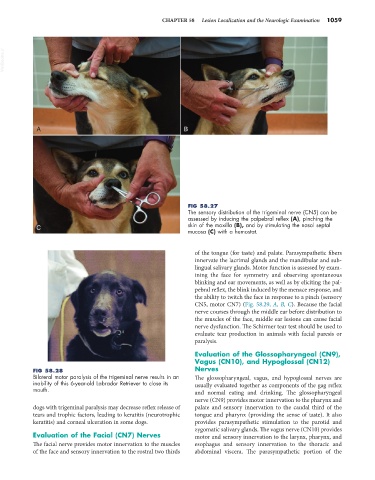Page 1087 - Small Animal Internal Medicine, 6th Edition
P. 1087
CHAPTER 58 Lesion Localization and the Neurologic Examination 1059
VetBooks.ir
A B
FIG 58.27
The sensory distribution of the trigeminal nerve (CN5) can be
assessed by inducing the palpebral reflex (A), pinching the
C skin of the maxilla (B), and by stimulating the nasal septal
mucosa (C) with a hemostat.
of the tongue (for taste) and palate. Parasympathetic fibers
innervate the lacrimal glands and the mandibular and sub-
lingual salivary glands. Motor function is assessed by exam-
ining the face for symmetry and observing spontaneous
blinking and ear movements, as well as by eliciting the pal-
pebral reflex, the blink induced by the menace response, and
the ability to twitch the face in response to a pinch (sensory
CN5, motor CN7) (Fig. 58.29, A, B, C). Because the facial
nerve courses through the middle ear before distribution to
the muscles of the face, middle ear lesions can cause facial
nerve dysfunction. The Schirmer tear test should be used to
evaluate tear production in animals with facial paresis or
paralysis.
Evaluation of the Glossopharyngeal (CN9),
Vagus (CN10), and Hypoglossal (CN12)
FIG 58.28 Nerves
Bilateral motor paralysis of the trigeminal nerve results in an The glossopharyngeal, vagus, and hypoglossal nerves are
inability of this 6-year-old Labrador Retriever to close its usually evaluated together as components of the gag reflex
mouth. and normal eating and drinking. The glossopharyngeal
nerve (CN9) provides motor innervation to the pharynx and
dogs with trigeminal paralysis may decrease reflex release of palate and sensory innervation to the caudal third of the
tears and trophic factors, leading to keratitis (neurotrophic tongue and pharynx (providing the sense of taste). It also
keratitis) and corneal ulceration in some dogs. provides parasympathetic stimulation to the parotid and
zygomatic salivary glands. The vagus nerve (CN10) provides
Evaluation of the Facial (CN7) Nerves motor and sensory innervation to the larynx, pharynx, and
The facial nerve provides motor innervation to the muscles esophagus and sensory innervation to the thoracic and
of the face and sensory innervation to the rostral two thirds abdominal viscera. The parasympathetic portion of the

